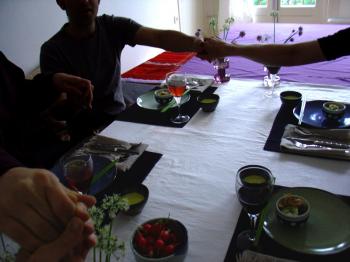Quandry: non locative comfort food
October 2, 2005
First things first, hats off to Auke Touwslager for inventing the term locative food on the 27th at the Food Design Symposium at the SMCS. For me this term pinpoints the quandry with which I am faced as a 3rd generation ex-pat. (With some folks it’s just baked into the genes.) Locative food is food that communicates location by its very nature. A truffle could communicate Occitania for example, and truffled eggs would seem to me out of place in Hawaii, Mongolia or Ghana, (unless things have changed drastically) but normal (although nonetheless special) in the Cevennes.
If we consider locally grown food to be desirable for our health, the health of the global environment and the health of the local economy, what do we do when we’ve transplanted ourselves to the other end of the planet and get a hunquering for non-local foods? Is eating a Pacific Rim style rice-bowl morally coherent as an inhabitant of the Netherlands? In an ideal world could we make choices about prioritising the import of certain non-local foodstuffs that we all think we need? My non-locative Dutch list would be:
coffee
rice (I have 7 types in my larder at all times, only 2 of these come from Europe)
soybeans and related products (my tofu and tempeh are produced within 2 km from my house, but the beans, where do the beans come from and are they GM?)
Occitanian wine
olive oil
sesame seed products (tahin, sesame oil, seeds)
most seeds and nuts
peanuts (and that Nectar of the Gawds called peanut butter)
According to the list above it seems that being a vegetarian in the Netherlands, would relegate me to eating quality lacking products made by culinarily handicapped hippies. The image above shows a version of my favourite rice-bowl dinner, of which only the beet leaves have been grown locally. Can non-locative comfort food be sustainable. Even as an enthusiastic porkatarian, I eat one heq of a lot of brown rice and soybeans.
debra at 11:40 | | post to del.icio.us


















the 7 types of rice in my larder:
- short grain brown rice (comfort food)
- long grain brown rice
- very long grain wild rice
- sushi rice
- red rice from the Camargue
- basmati brown rice
- basmati white rice
PLUS other non-local grains:
- sticky rice (not always in the larder)
- millet (mmm!)
- quinoa (still trying to like it for some reason)
- amaranth (idem ditto)
- popcorn (trying not to have this in my larder due to high glycemic index)
- rye
- wheat berries
- something larger than a wheat berry that looks like a wheat berry
- corn flour
- brown chapati flour
- white flour
- pastry flour
- semolina
- bulgur wheat
What I hope to never have in my larder:
- kasha/buckwheat (tastes and smells just like ‘dirt’, with a little bit of ‘wet dog’ thrown in for good measure, feh)
Comment by Debra — October 2, 2005 @ 20:29
debra!
very nice blog! i do not have your mail address to let you know that tea is served again at the Hortus Botanicus in Amsterdam on sunday afternoons the 9th and 16th of october. Amsterdam China Festival, China Tea festival 2005, tell all about the Chinese Tea Ceremony: www.teahouse.nl and join us at sunday afternoon.
mathijs
Comment by mathijs — October 4, 2005 @ 11:42
Dear Matthijs,
Can’t wait till Sunday. nice to see you here.
Warm regards,
Debra Solomon
Comment by Debra — October 4, 2005 @ 13:16
Since you showed yours, I’ll show mine. At all times:
-Japanese sushi rice, usually from California
-Italian arborio rice
-Thai jasmine rice (this is the one I eat most often)
-American long-grain white rice
-American medium-grain brown rice
-Indian basmati rice
-Wild rice, from Minnesota, I think, but..ok I’ll be pedantic: wild rice isn’t actually rice
Now to the substance: I find your moral abolutism a bit charming and also a bit troubling. It’s wrong to eat foods from afar? I’m not sure that is always true. Where I live, in a northern United State of America, there is practically no fresh produce available for much of the year and I’m really glad we can get things like fresh lettuce, tomatoes, and bananas in February. We’re happier and healthier when we have these things, and I don’t accept that this is morally questionable. Local is good, but this doesn’t entail that not local is always bad.
Oh, and I love kasha. I’m having some for dinner tonight.
Comment by mzn — October 5, 2005 @ 1:02
Debra,
What are the ecological implications of growing non-native foods just so we may have locally grown products? Potatoes are, after all, from central and south America. Tomatoes—central America. Rice—Asia. Peanuts—Africa. So why should there be such concern about trans-shipment of food stuffs. Should us northern Californians not be able to enjoy table grapes nearly year round—from our own Central Valley in late summer, tfrom the Imperial Valley in the late spring, and from Chile in the winter?
Comment by dad — October 6, 2005 @ 4:57
Dear Dad,
Growing non-native foods is something that I should investigate. I can imagine that thirsty crops grown in the desert are a bad idea, and my instinct tells me that growing crops locally is better than the cost to the environment incurred by large transportation distances. This seems to be a question for an institute that studies just this. I’ll find out.
Liefs,
D
Comment by Debra — October 11, 2005 @ 19:17
Dear MZN (Haverchuck),
Thank you for pointing out that I’m a moral absolutist, or absolutely a moralist. One doesn’t have to live very far north to not have fresh leafy greens available all the year round. Even when I’m down in Occitania I don’t have access to bananas - which is OK because I don’t really like bananas. They’re the new liver.
Wouldn’t it be a nice experiment though, a relatively painless one that could bring us back to our relationship with our location, if we just ate the food that was already around us? Root and cruciferous vegetables in the winter. And there is plenty of winter fruit, although, due to agricultural homogenization there is not often a lot of choice as to say, apple variety.
February and March are the tough months, the ‘hungry gap’ as farmers refer to them. Maybe a good time for a fast in this period? Catholics did until not so long ago fast in this period. Lenten fare, anyone?
I’m not a Catholic (oh?), but I do live in a cold and dark northern climate and I, like you, buy my food at the farmer’s (read posh people’s) market - and there’s always plenty of fruit and veg all year round, for all of us city folk.
Luvvin yer blog btw.
Warm regards,
Debra
Comment by Debra — October 11, 2005 @ 19:42
Debra,
I am talking with one of my professors in hopes of doing an independent study next semester on local food and business (unfortunately I chose to be a Business Administration major). As of now we’re looking to study the possibility of using local food to create a co-op restaurant in the area (Fredericksburg, Virginia, USA). On a similar tangent, we talked about promoting local Virginia food and creating a website for tourists coming to the area. A map will direct them to restaurants that serve locally grown foods, as well as locating the produce. The idea is the state or agriculture groups could support this idea and create guidelines for what is local and sustainable (going beyond what is merely organic). Another tangent is creating a restaurant that advertised the local growers that supply the restaurant. The menu could direct them to a website for each local ingredient.
Clearly, we’re still brainstorming. I mentioned your blog at our meeting and remembered the term “locative food” from this entry. I also remember and older entry on designing a kitchen for slow food cooks serving typical American fast food. I am just wondering if you any ideas on this project or any information in the direciton I am going. Thanks for your help,
Matt
Comment by Matt — October 11, 2005 @ 21:38
Dear Matt,
You’re smart to be a business major. You could have studied harsichord, early music, and art like I did, all very practical studies.
ABOUT YOUR PROJECT: It’s an amazing coincidence because I have assigned my students at the Design Academy Eindhoven (Atelier, FOOD) the task of designing their own kitchen. We didn’t have a kitchen and one of my students squatted an ex-bordello (!!!) and we’ve decided to turn part of the ground floor into the cooking lab for the food design course and to programme the space, which is in an ethnically rich neighbourhood, with food projects.
Maybe we could do some parallel work? I’ll send you their assignment (although it’s geared to design students) and let you know how we’re progressing.
I love the idea that in your website concept you go beyond organic to focus on local, and I LOVE the idea of setting up a co-op restaurant. The restaurant concept should be pretty simple and weird if you want to attract lots of attention. Look at this SWEETS STUDIO that I visited today (and will write about later this week) (http://www.papabubble.nl). They have a simple candy concept and make the cool candies in the shop. The place is swarming with kids. Okay - that’s not local, fresh produce they’re selling, but…the kitchen and store design are simple, the product, simple, the owners, devoted, the place WORKS.
Now if you could choose just one piece of produce and make a product out of that… (make something cool, zucchini jerky or some new sort of candy, hors d’oeuvre, bread, cracker), or set up a kitchen that hosted one product each month. The public would be informed that this was the only month to get all things pear, or leek or…
I’m thinking that you might want to explore narrowing down your possibilities so that you keep your costs low (in kitchen design), and keep your public and the press on their toes. Maybe in the course of the year, the local produce is very finely presented in your restaurant.
Let’s keep batting stuff back and forth. Hope this was some help.
Warm regards,
Debra
Comment by Debra — October 11, 2005 @ 23:53
Dear Debra,
While business is practical, your studies are interesting.
First, off I’d like to say thank you for such a speedy and detailed response. Your ideas are very helpful!
As far as my project, I’m not sure i’ll actually get to design the kitchen, but more so design the business plan. Ideally, after the one semester of doing research, I could possibly sell the idea or stay in the area and continue working on the project.
I really like your idea of making it simple in design and with the number of products. I also love the idea of having one product each month. Perhaps this could tie in with seasonal as well as local produce. October could be a month of gourds, November winter squash… and so on. Maybe I could create a business plan for opening a co-op restaurant featuring local produce that changes each month, or season?
Just clear up something. Are you saying it is best to start with one product and grow over time? Is one product a month a marketing strategy as well as a cost-effective solution?
Thanks again for your help. I’ll keep you updated.
Take care,
Matt
Comment by Matt — October 12, 2005 @ 23:16
http://www.ethnicgrocer.com/ Food taxonomized by country?
Comment by Auke — October 25, 2005 @ 15:53
oy
vey
is
mir
Comment by Debra — October 26, 2005 @ 13:21